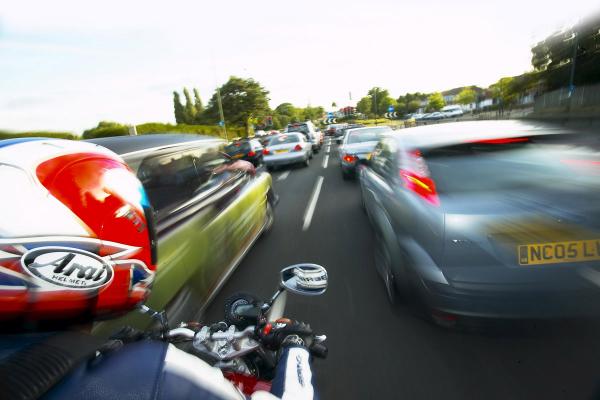
By Alan Dowds
IT'S the entire point of a bike in town of course: filtering through crappy traffic makes up for what can sometimes be a cold and wet bike commute. But how to do it better? Here's our top tips on filtering from Alan Dowds, who's been bashing his way through city traffic for almost three decades…
1: Start gently
If you've recently passed your test, then be careful here – filtering can be a risky endeavour, and you'll need to build up your brain's inner software subroutines gradually. Start with simple filter jobs – getting to the front of a red light, say, rather than going straight for the 65mph M25 kamikaze efforts.
Don't be afraid to be right out on the opposite side of the road when overtaking stationary traffic. It gives you a better view of any oncoming traffic and therefore more time to react to it. Also, you get more time to react when pedestrians emerge from between cars you're overtaking.
Slowly, slowly, catchee monkee, and try not to catch a speeding van up your backside.
In many ways, you still need to stick with the knitting here: engage totally with your environment, looking as far ahead as you can, and pulling in every scrap of intel on what's happening around you. Read the road, and the traffic jam up ahead – is there two lanes going into one? Then you can nip to the outside and ride down the clear gap left by the cars merging. Is there a right turn filter lane that's empty? It’s yours for a fast forward to the head of the queue. Is that bus about to disgorge a hundred zombiefied commuters who'll be crossing to the train station? Get ready for them wandering into your path.
Don't think you have to use the bus lane just because you can. Sometimes you get a better view of the road ahead and make better progress by overtaking traffic on the right. You're also less likely to be taken out by cyclists or a car crossing the bus lane from a side road. While we're on bus lanes – not all are legal for bikes to use. Look carefully at the signs, and find out the local by-laws in your area.
Particularly in town, you need to constantly scan for short-range hazards. Pedestrians emerging from behind buses is a favourite, or crossing on a Pelican crossing with a red man – the cars aren't moving, so they think they can cross.
With other vehicles, learn to watch for sudden turns: last minute indicators, front wheels turning out, cars, drifting out of their lane slightly. It doesn’t matter who’s at fault. This is the environment you ride in and you pay a price for not negotiating it safely.
Pre-load your braking response too: have hand and foot on brake levers and clutch, ready to hit the emergency anchors instantly. And yes, we think DVSA advice to not cover the front brake is bollocks, or at best only applicable to absolute beginners. Saving a tenth of a second makes you less likely to panic and grab too much, not more. Or it can make the difference between a crash and a near-miss.
This looks mental, especially to untutored car drivers. And doing it too fast – for example at 65mph in 50mph traffic - could get you a tug from the cops. But motorways are actually among our safest roads, and sometimes filtering on them is the safest thing to do, especially when traffic is queuing. You never want to be the last in line because that’s the vehicle that gets rear-ended. What you have to watch for most is the pitfalls – that is, spots where cars can and will suddenly change lanes. If the traffic is nose-to-tail, with no gaps, then you're actually safer, because a car won’t try to change lanes if there's no space to move into. Choose a low gear for more engine noise and control and have a thumb poised on the horn button. Some riders put their hazards on too (although this seems like an unnecessary tacti admission to hazardous riding).
As ever, have your full-brake game poised and ready to go: hands and foot on levers, with free play taken up.
Don’t let a false sense of security draw you into doing it too fast. The risk of a crash may seem lower than on other roads, but the consequences of one happening could be more serious due to the higher speeds. In short, yor first mistake is more likely to be your last.

